Vicony Tea Directory


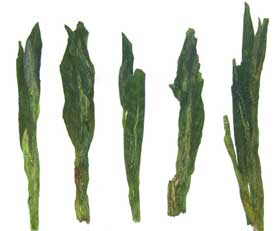 |
|
| Hou Kui Tea- Monkey King Tea |
Hou Kui Tea(猴魁茶)
What's Hou Kui Tea
Taiping Hou Kui (simplified Chinese: 太平猴魁; pinyin: tàipínghóukuí.) tea also called Monkey King is grown at the foot of Huangshan Mountain in Taiping County, Anhui Province. The tea was first made at the beginning of the 20th century in a small village named Hou Keng (猴坑). In 1915,Hou Kui Tea won Gold Prize along with Keemun Tea, another famous tea produced in Huangshan area,in the Expo held at Panama.
Hou Kui Tea is renown for its "two knives and one pole": two straight leaves clasping the enormous bud with white hairs. The oven-made leaves are deep green in color with red veins underneath.
The leaf of Hou Kui Tea measures up to 60 mm. It is the largest sized leaf tea among the famous green teas. But surprisingly its size does not affect its delicate orchid fragrance with a mellow taste which lasts up to four brewing. In a glass,the leaves gracefully sway in the water which is described as the ‘Phoenix dance’.
As the production area is very small and demand is huge, falsification of hou kui tea is rampant. Authentic hou kui tea is rare and very expensive. It is difficult to obtain it,even in China.
Hou Kui Tea's History
As one of historically famous tea in China,hou kui tea was first made in Qing Dynasty in Anhui Province. It belongs to the rare group of tea, i.e., the sharp-shaped green tea (尖茶 Jian-cha).
It is said that the production of sharp-shaped tea (尖茶Jian-cha) bloomed during the Qing Dynasty. Taiping County,at that time,was one of the main producing areas and had a tea trading center in it. In the past,people used to produce Jian-cha with leaves in various size and containing a lot of old leaves.
Later on,some people started to select the dried leaves which contain only one bud with 1-2 leaves from the finished product and then sold it. This selected tea was appreciated and can be sold at higher price. The fact inspired a farmer named Wang Kui-Cheng (王魁成) who began to produce the tea only using fresh leaves which contain one bud with 1-2 leaves rather than selecting the dried leaves afterwards. He made a hit. His tea was highly praised and sought after. As his tea was of best quality(in chinese,the number one is called 魁首 Kui-shou) and his name is Kui-Cheng (魁成),furthermore it was produced at Hou-keng (猴坑) area,so came out the name Taiping Hou Kui.
1900: Hou kui tea was first brought to the exhibition held by the agricultural and commercial department at Nanjing (南京); it was highly praised and became a renowned tea in China.
1915: Hou kui tea won the gold prize in the Expo held in Panama.
1955: Hou kui tea was selected as one of the Top Ten Teas in China.
1988: At the First China Food Expo,hou Kui tea won the gold prize.
2004: Hou kui tea was given the highest honor prize (The King of Tea) at the China International Tea Expo held at Wuhu City of Anhui Province.
Now,Hou Kui Tea is one of the most sought-after teas in China. For many times,it was presented to foreign dignitaries. In 2007,it was given to Russian President Putin as national gift by Chinese President Hu Jingtao during his visit to Russia and won Mr. Putin's great acclaim.
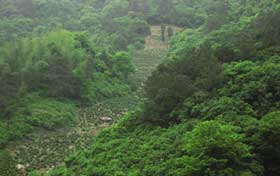 |
|
| The Growing Area of Hou Kui Tea |
The Growing Area of Hou Kui Tea
The production area of the authentic Taiping hou kui tea is confined to three villages which are Houkeng (猴坑 Monkey Pit),Hougang (猴岗 Monkey Hillock) and Yanjiacun (颜家 Yan Family Village). The three villages are all located at Xinming Township(新明乡 Xin-ming Xiang),Huangshan City,Anhui Province. The tea gardens are scattered among the mountainous area where primitive forest and effloresced rock make soil fertile and rich in mineral,ensuring exuberant growth of tea plant.
Tea Cultivar and Plucking season of Hou Kui Tea
Hou Kui Tea is made of tea leaves of an unique tea cultivar,called Shi-da Cultivar (柿大品种 Shi-da Pin-zhong). The rare cultivar is specifically bred for hou kui tea. Its leaves are big,oval shaped,thick but soft and covered with white down. The young leaves are pale green while mature leaves are dark green and shinny with uneven surface and wavy edge. The bud can grow up to 2 - 2.5cm (length).
It is said that the best time to harvest leaves of hou kui tea is only 14 days in total throughout a year,a period falls between Grain Rain (谷雨Gu-yu, the 6th Solar Term of the 24 Solar Terms of in traditional East Asian lunisolar calendars) and the beginning of summer (立夏 Li-xia, the 7th Solar Term). During summer,the lower grade of tea produced is called Jian-cha (尖茶).
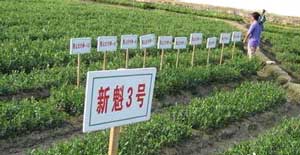 |
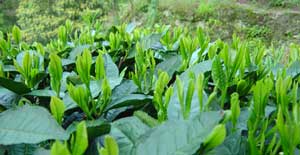 |
||
| The young plant of Shi Da cultivar | Shi Da Cultivar |
Production Process of Hou Kui Tea

拣尖 (Jian-jian) - Picking
After all the tea leaves are plucked,they will undergo rigorous selection process to meticulously examine every twig(one twig = 1 bud and 3 leaves) and to choose the twig which is robust and well grown. After the process,only one bud and two leaves remain in very twig – one of the three leaves was removed. The remained two leaves must be almost as long as the bud, i.e. 6 cm in overall. Generally speaking,one kilogram of Hou Kui Tea consists of about 20,000 buds. After selecting,the leaves are similar in length and appearance.
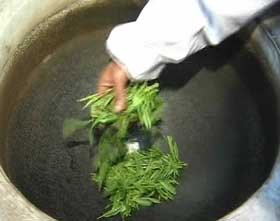 |
|
| Pan Frying of Hou Kui Tea |
殺青 (Sha Qing) – Pan Frying – Inactivation of Enzyme(Blanching)
The purpose of 殺青 is to inactivate oxidative enzyme such as polyphenol oxidase (PPO) with heat.
Pan frying is to fry tea leaves in a metal pan when the temperature of pan reaches 120 - 130˚C. With high temperature,it takes very short time to heat the tea leaves and inactivate oxidative enzyme. Although Pan with sharp bottom base (尖底锅 Jian-di Guo) is commonly used in the production of other types of Chinese green tea,a deep flat bottom base pan (深底平锅 Shen-di Ping-guo) is needed for making hou kui tea because of its distinctive appearance.
Beforehand,make sure the pan is thoroughly cleaned until smooth and shinny. When the temperature reaches 120 - 130˚C,place about 75-100g of tea leaves into the pan and fry it for 3 – 4 minutes. With fingers slightly curved,lightly stir-up the tea leaves from bottom to the edge of pan,then quiver for 2 – 3 times and let the tea leaves evenly spread out and drop back into the pan. In every minute,fry and stir for about 30 times. After 3 – 4 minutes of frying,the leaves begin to turn dark green and lose lustrous appearance. With slightly crispy edge they start to emit pleasant fragrance. It is a sign of sufficient frying. Thus,the tea leaves should be removed from the pan and transferred to the bamboo plate to cool down and vaporize (the moisture content of tea leaf will be reduced to about 70%).
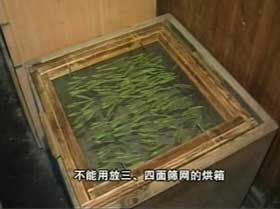 |
|
| The 1st Heating of Hou Kui Tea |
初烘 (Chu Hong) - 1st Heating – The formation of shape
This is the most critical stage to make hou kui tea with acuminate-sharp shape. Each pan of fried tea leaves will be served with four air ovens heated at different temperatures. The first air oven is heated up to 110˚C,the following oven is heated to lower temperature i.e., 100˚C, 85˚C and 60˚C,respectively. The tea leaves on the bamboo plate are placed on the top of the first air oven,and then lightly knock at the edge of bamboo plate to disperse the leaves over the plate and heat for 2-3 minutes. Then the leaves are transferred to the second air oven and heated for 2-3 minutes. While tea leaves are still warm and soft,they are lightly pressed using both palms to shape the leaves. Following that,they are again transferred to third air oven and the same steps are repeated. When the leaves are transferred to the last air oven and heated for 2-3 minutes,the moisture content of leaves are reduced to about 15% and at this stage,the partially dried leaves harden and no pressing is applied any more as to avoid causing damage to the leaves. Overall,the first heating takes about 12 minutes.
Finally,the leaves are transferred to a bamboo plate for cooling (about 1 hour). The re-distribution of the moisture from the stem to surface leaf is underway,creating the conditions for tea leaves to go through the next stage of heating. The main purpose of the first heating is to vaporize moisture from the leaves as soon as possible,halt remnant enzyme activity,preserve the green color of leaves and at the same time,form the shape of hou kui tea.
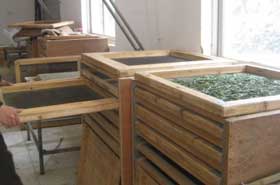 |
|
| The 2nd Heating of Hou Kui Tea |
二烘 (Er Hong) -Second Heating
About 4-5 plates of tea leaves from 1st heating are gathered together and proceed for the second heating. The temperature of air oven is about 80˚C. After placing the tea leaves on the plate,lightly pat the plate several times until all the leaves are evenly scattered over the plate,use palm to lightly press the leaves thoroughly; this is to strengthen all the leaves. Leaves have to be turned around in every 5-6 minutes,repeating for 5-6 times,thus,the overall process takes about 25-30 minutes. Remove the leaves from the air oven when the moisture content is reduced to about 10%. Before proceeding to the next heating,the leaves would be left on the bamboo plate for cooling down. It takes 5-6 hours to re-distribute the moisture.
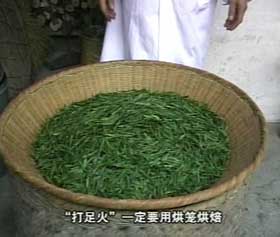 |
|
| The 3rd Heating of Hou Kui Tea |
三烘 (San Hong) -Third Heating
After sufficient cooling,the leaves (0.5 – 1 kg) will be placed on the top of heating basket (烘笼 Hong Long)for the 3rd heating at 60˚C. Again,tea leaves have to be turned around in every 5 minutes,repeating for 6 times.,The overall process takes about 30 minutes. During the heating process with Wen-huo (文火, mean smoldering fire)at lower temperature,the tea leaves begin to smell fragrant.
After the moisture content is further reduced to 5-6%,the tea leaves will be removed from the heating basket and left on a bamboo plate to cool down (0.5 – 1 hour),and then packed.
Quality Inspection Criteria For Hou Kui Tea
Leaf Shape of Hou Kui Tea
Leaves of hou kui tea are fleshy,robust,straight with tips. The authentic hou kui tea only consists of twigs of one bud embraced by two leaves. Hou kui of poorer quality usually contains single leaf without bud. This is not genuine Taiping hou kui but hou jian (猴尖) which is made from the 3rd and/or 4th leaves that was left after the selecting of leaves for hou kui tea. Poor quality hou kui is always mixed with broad leaves,sometimes ‘chopped’ and without tips. When compared to that of good quality,it is often over-pressed and twisted out of the normal natural shape.
Leaf Color of Hou Kui Tea
The authentic Taiping hou kui tea is pale green,even,bright and lustrous. Leaf is covered with fine white down and closely well set to leaf and hidden;it is not easily seen and will unfurl when brewed. Poor quality tea is either very light shinny green or dark green,with lots of down that is outstretched and clearly seen.
Consistency
The good quality tea consists of dry leaves in regular shape. Poor quality tea contains a lot of broken leaves of various sizes and shapes. Leaf is not in the whole twig form with attached bud and leaves but contains crushed and separate leaves. The color is a mixture of yellowish green or dark green color.
Cleanliness
The well-made tea must be free from extraneous matter such as fiber,bamboo or wooden flakes,sand,stone and dust.
Aroma and Flavor
When brewed,the liquor is sweet,mellow and refreshing with long-lasting orchid aroma.
Color of Liqure
Bright,clear and transparent,with very light yellowish green color.
Brewed Leaves of Hou Kui Tea
The brewed leaves appear to be fresh,bright and green. When touched with finger,the leaves are thick but soft and elastic. The thin red line is seen at the main leaf vein,indicating the tea is made from the authentic Taiping hou kui cultivar. If it is of poor quality,the leaves are dark green with dull appearance. When touched, the leaves are thin and stiff.
| Green Tea | Black Tea | White Tea | Yellow Tea | Oolong Tea | Dark Tea | Pu Erh | Scented | Flowering | Herbal | Tea Powder |
| Navigation |
| Home (ViconyTeas) |
| Tea Directory (VTD) |
| Tea Importers |
| Tea Exporters |
| Tea Wholesalers |
| Informative Tea Web |
| Tea Association |
| Tea Encyclopedia |
| Online Tea Shop |
| Tea Dictionary Online |
Copyright©2016 | Hou Kui Tea

